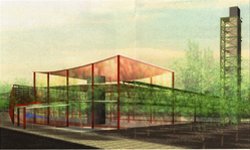 Stevens’ rendering of their proposed Harbor Estuary Center makes the building appear transparent.
Stevens’ rendering of their proposed Harbor Estuary Center makes the building appear transparent.
(March 10, 2002)
Hoboken is now tantalizingly close to creating a truly public waterfront. The city has nearly completed a continuous park running the entire one-mile stretch of the Hudson River from the Hoboken Train Terminal to the Weehawken Cove. Only three sites remain undeveloped.
Yet one obstacle stands in the way of the completed waterfront park — Stevens Institute of Technology. Stevens has come forth with proposals for all three of these sites, which would privatize the land and obliterate the chances for a continuous park.
On the property between Sinatra Park and Castle Point Park, Stevens has proposed blocking the waterfront with a building 400 feet long — the length of a long Hoboken city block. Dubbed the “Harbor Estuary Center,” this building would house the Davidson Laboratory’s wave tank, which currently resides on Hudson Street. Stevens wants to move the lab to redevelop scarce space on the campus for luxury housing. The lab at its new site would also house offices for the Port Authority of New York and New Jersey, the Army Corps of Engineers and the New Jersey Department of Environmental Protection. As planned, the building violates the Hoboken zoning ordinance in respect to permitted uses, building height and lot coverage.
As part of its public relations effort, Stevens has prepared renderings that make the building appear invisible. But no matter how much glass is included, this structure, like any other office building, will not disappear before our eyes. Stevens claims the building is a water dependent use. But neither the wave tank nor the offices require a waterfront location. Stevens also claims the building will be fully accessible to the public, but in fact it will be a private building, privately controlled. Further, on one of their truly premier parcels of vacant land, directly across the street from this building and from the river, Stevens has proposed a bleak, massive parking garage.
At the Union Dry Dock property, just north of Castle Point Park, Stevens proposes to build a private athletic facility, including a soccer field and running track. This facility would require either landfill or several acres of decking over the Hudson River, at a time when the State Department of Environmental Protection and the U.S. Army Corps of Engineers have recognized the negative environmental consequences of these actions. If the fields were ever built, they would be among the most expensive university play facilities in America. Again, Stevens promises to make this facility open to the public. Stevens’ track record, however, speaks for itself. Its long history of excluding the Hoboken community from its athletic facilities and its campus does not bode well.
At the third site, the former Maxwell House Coffee plant, Stevens has proposed rebuilding two sheds: one on a 3-acre earthen peninsula, the largest waterfront parcel on the property, and another that encompasses the long northern pier. If this project were to proceed, the battle won by civic organizations more than a year ago to keep buildings off the piers at Hoboken’s northern waterfront would have to be fought yet again.
Several months ago, the Fund for a Better Waterfront presented detailed plans for all of these waterfront sites to representatives of Stevens and to the Mayor of Hoboken. These plans support all of Stevens’ proposals and accommodate its need for additional parking and building space, yet the public nature of the waterfront is kept intact by placing the offices and wave tank on the western side of Sinatra Drive. The Fund has designed a parking garage that is appropriately enclosed behind new buildings and not visible from the waterfront. These are common sense, economically feasible solutions that Stevens Institute and the City of Hoboken have chosen to ignore.
The Fund has also proposed the creation of a new five-acre park, east of Sinatra Drive at Maxwell House, where Stevens plans to erect buildings on the piers. This uptown park would be one of Hoboken’s great glories. It would be fully accessible to the public, opening views of the Hudson River and New York City skyline in all directions. More importantly, the property owners have agreed to make a charitable contribution of this prime waterfront real estate, and to build and maintain this public space with private funds, in perpetuity, at a level of quality rivaling Central Park in Manhattan.
Hoboken is faced with a critical choice: do we want to settle for a waterfront interrupted by buildings and private facilities, and marked by unsightly parking garages, or will we raise our level of expectations and demand a spectacular, continuous waterfront park? In neighboring cities where private developments abut the state-mandated 30-foot wide riverfront walkway, the public’s access to and enjoyment of the waterfront has been seriously diminished. Hoboken’s public park is already 70% finished, but with these few key parcels of land yet to be developed we have the unique opportunity to pull the waterfront together as a cohesive, fully accessible destination point for all of the public, for generations to come.
Hoboken’s mile-long waterfront park can be completed within the next four years. But this will require the cooperation of Stevens Institute and every level of government. At stake here is the legacy left by all of us, the community of Hoboken, the administration of Mayor David Roberts and Stevens Institute of Technology.
Hoboken Reporter
Editorial by Fund for a Better Waterfront
